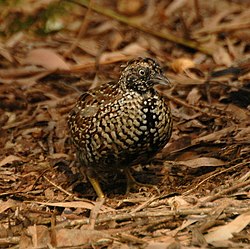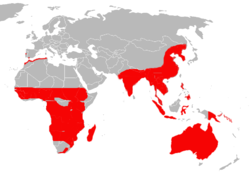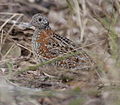Buttonquail
| Buttonquail | |
|---|---|

| |
| Black-breasted Button-quail (Turnix melanogaster) | |
| Scientific classification | |
| Kingdom: | |
| Phylum: | |
| Class: | |
| Order: | |
| Family: | Turnicidae GR Gray, 1840
|
| Genera | |

| |
| Distribution of the Buttonquails. | |
Buttonquail or hemipodes are members of a small family of birds, Turnicidae, which resemble, but are unrelated to, the quails of Phasianidae. They inhabit warm grasslands in Asia, Africa, Europe, and Australia. There are 16 species in two genera, with most species being found in the genus Turnix and only one being found in the genus Ortyxelos.
Buttonquails are small, drab, running birds, which avoid flying. The female is the more brightly coloured of the sexes, and initiates courtship. Unusually, the buttonquails are polyandrous, with the females circulating among several males and expelling rival females from her territory. Both sexes cooperate in building a nest in the earth, but only the male incubates the eggs and tends the young. The eggs hatch after an incubation period of 12 or 13 days, and the young are able to fly within two weeks of hatching[1].
Taxonomy
Buttonquail were traditionally placed in Gruiformes or Galliformes (the crane and pheasant orders). The Sibley-Ahlquist taxonomy elevated them to ordinal status as the Turniciformes and basal to other Neoaves either because their accelerated rate of molecular evolution exceeded the limits of sensitivity of DNA-DNA hybridization or because the authors did not perform the appropriate pairwise comparisons or both. Morphological, DNA-DNA hybridization and sequence data indicate that turnicids correctly belong to the shorebirds (Charadriiformes).[2][3][4] They seem to be an ancient group among these, as indicated by the buttonquail-like Early Oligocene fossil Turnipax and the collected molecular data.[4]
Description
The buttonquails are a group of small terrestrial birds. The smallest species is the Quail-plover, the only species in the genus Ortyxelos, which is 10 cm (3.9 in) in length and weighs only 20 g (0.71 oz). The buttonquails in the genus Turnix range from 12 to 23 cm (4.7–9.1 in) in length and weigh between 30 to 130 g (1.1–4.6 oz). They superficially resemble the true quails of the genus Coturnix, but differ from them in lacking a hind toe and a crop. The females of this family also possess a unique vocal organ created by an enlarged trachea and inflatable bulb in the oesophagus, which they use to produce a booming call.
Species
Family: Turnicidae
- Genus: Ortyxelos
- Quail-plover, Ortyxelos meiffrenii
- Genus: Turnix
- Small Buttonquail, Turnix sylvatica
- Philippine Buttonquail, Turnix worcesteri
- Sumba Buttonquail, Turnix everetti
- Hottentot Buttonquail, Turnix hottentotta
- Yellow-legged Buttonquail, Turnix tanki
- Barred Buttonquail, Turnix suscitator
- Madagascar Buttonquail, Turnix nigricollis
- Spotted Buttonquail, Turnix ocellata
- Black-breasted Buttonquail, Turnix melanogaster
- Painted Buttonquail, Turnix varius
- New Caledonia (Painted) Buttonquail, Turnix (varius) novaecaledoniae (extinct: early 20th century)
- Chestnut-backed Buttonquail, Turnix castanota
- Red-chested Buttonquail, Turnix pyrrhothorax
- Red-backed Buttonquail, Turnix maculosa
- Little Buttonquail, Turnix velox
- Buff-breasted Buttonquail, Turnix olivei
-
Barred Buttonquail (Turnix suscitator)
-
Small Buttonquail (Turnix sylvatica)
-
Painted Buttonquail (Turnix varia)
-
Red-chested Buttonquail (Turnix pyrrhothorax)
References
- ^ Archibald, George W. (1991). Forshaw, Joseph (ed.). Encyclopaedia of Animals: Birds. London: Merehurst Press. p. 101. ISBN 1-85391-186-0.
- ^ Paton TA, Baker AJ, Groth JG, Barrowclough GF (2003). "RAG-1 sequences resolve phylogenetic relationships within charadriiform birds". Molecular Phylogenetics and Evolution. 29 (2): 268–78. doi:10.1016/S1055-7903(03)00098-8. PMID 13678682.
{{cite journal}}: CS1 maint: multiple names: authors list (link) - ^ Fain, Matthew G. & Houde, Peter (2004). PDF fulltext "Parallel radiations in the primary clades of birds". Evolution. 58: 2558–73. doi:10.1554/04-235. PMID 15612298.
{{cite journal}}: Check|url=value (help)CS1 maint: multiple names: authors list (link) - ^ a b Paton TA, Baker AJ (2006). "Sequences from 14 mitochondrial genes provide a well-supported phylogeny of the Charadriiform birds congruent with the nuclear RAG-1 tree". Molecular Phylogenetics and Evolution. 39 (3): 657–67. doi:10.1016/j.ympev.2006.01.011. PMID 16531074.
- Sibley, Charles Gald & Ahlquist, Jon Edward (1990): Phylogeny and classification of birds. Yale University Press, New Haven, Conn.
External links
- Buttonquail videos on the Internet Bird Collection
- cyberquail




